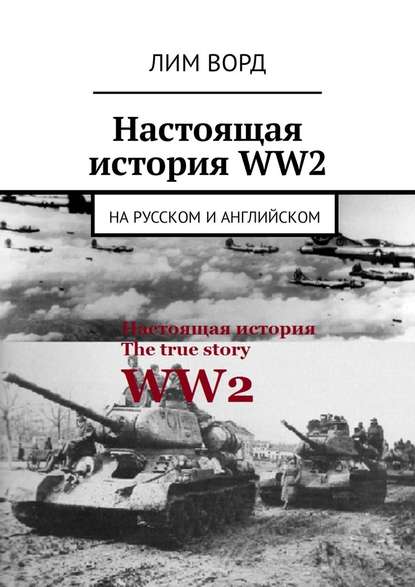По всем вопросам обращайтесь на: info@litportal.ru
(©) 2003-2024.
✖
Настоящая история WW2. На русском и английском
Настройки чтения
Размер шрифта
Высота строк
Поля
Further on this topic: «I reject Christianity, because it is the product of Judaism, because it is internationalistic and because it preaches peace on earth.»
(Adolf Gitler).
In general, we can say that the entire people of the USSR, the Soviet Army (RKKA), are moving towards God during the war, and Germany (the Axis countries), on the contrary, step by step, move away from it. «God is with us,» the inscription engraved on buckles of belts becomes an empty formality. In the second half of the war, the funeral rites of SS men are most often conducted, according to the pagan custom of the Vikings, with the Lebens rune (the rune of life, something like an arrow pointing downwards, or a trident, or Toten-Rune, or Tyr-Rune) on the grave, instead of a cross.
The Battle for Dubno-Lutsk-Brody
On June 23, the battle for Dubno-Lutsk-Brody (320 km west of Kiev) starts. The General of the Army G. Zhukov, who came to the scene, rejects the idea of the Chief of Staff of the South-Western Front to withdraw troops and create a solid defense line. The new plan was an immediate strike by five mechanized corps in 2,800 (later 3,100) tanks for four (subsequently – five) German tank divisions of 720 tanks and 70 assault guns.
Wehrmacht connections, in addition to combat vehicles, include large units of infantry, artillery, and also highly skilled repair brigades. Bulky (about 400 tanks) mechanized corps make marches of 300 km, losing at least only a mechanical breakdown of at least a quarter of the machines.
The Soviet system of production of military equipment allegedly does not provide for the release, delivery, not even worth a half-word, of «small things» for repair, for example, gaskets or tank tract. Guidelines for driving and servicing the newest tanks, at this time – are classified even from potential mechanics. Sometimes, so carefully stored from the crews of the car, at the most crucial moment refuel not with diesel fuel, but with gasoline.
Approximately the same situation in the Air Force. In order to avoid any breakdown of equipment, getting accusations of wrecking, the most unfortunate consequences, the lower command is gradually sabotaging real military training. To realize how this or that thing works, one must at least break it down – it’s a simple, but an immutable truth. The fact that in the German educational units is punishable with salty jokes or a reprimand to a newcomer, the Red Army may end in execution.
Perhaps, it can be argued that in a society of formal equality and the «territorial organization of the community», any sign of distinction is qualified, no less than an accessory to a special caste. The Commander of the Red Army at all costs aspires to secede from the soldiers’ masses, although of course this does not go as far as in the Tsarist army. These maxims completely agree with the author’s observations during his time in the army of the Soviet, and then Russian. The German army from the middle of the nineteenth century implies, with (paradoxically) the strict observance of subordination, the attitude of the officer to the soldier as an equal to himself. Cohesion, a trusting relationship to each other, even, as it is said there, on the basis of blood ties, determines the high level of command and control.
So, there are counter tank fights near Kiev, sometimes successful, more often – no, massive frontal offensives on the positions of German anti-tank guns, maneuvering without communications and normal maps, separation from supply and repair lines. The result: by 30 June the Red Army loses 2,600 tanks, the Wehrmacht – 180 (irretrievably). The entire South-Western Front is crashing down.
Stalin realizes the reality of such a picture: he is confronted with a group of German generals, with Hitler, compelled to answer their questions, unimaginably small and pitiful. This Dzhugashvili does not like, and he, even if not immediately, begins to make more or less correct decisions. The principle of eliminating problems, before – to see only the good, to discard all that is not part of smart plans. If someone talks about dying of hunger – they should be made to confess to espionage to Britain, and the question is solved. Twenty years after the Revolution, the people live worse than in 1914 – let’s say that this is not true, and the end is the matter. In Moscow (supply in a special category), after the cards have been canceled, thousands of queues are snapping around the stores – comrades from the NKGB warn the townsfolk without proper registration, that their next visit to the capital will be punished by article for speculation – and the crowds quickly disappear. Why bother with the actual development of the production of this boring consumer goods? The Scout believes that the Finns will not take the bread and salt of the Red Army – he should be summoned to Moscow and eliminated. It is the same with reports of the situation with the preparation of troops, or Hitler’s plans for an invasion. Those who express unpleasant, should be removed – and everything becomes pleasantly quiet.
But, this time, if we do not see the armored columns of the Wehrmacht, they do not cease to exist, and the mental image: Stalin before the smiling German military is becoming more real.
The first orders are to «shoot». It does not get better from that. Earlier, it was possible to establish ubiquitous deathly silence. Now the clanking of the caterpillars of German tanks is becoming more and more distinct. The commanders are getting cold hands, blood is pouring from the brain, resentment is rising in the chest – nothing more.
Stalin has to set aside executions, empty slogans, and solve the problem, now delving into the essence of what is happening. The control system is reconstructed into a real solution of the problems. This works from the second half of 1942, to May 45th, and, for two and a half years, allows you to get away from almost complete collapse to victory.
In the absence of a threat to the personal well-being of the leader, in the second half of 1945, the former system of interaction of power with the people experiences, as they say, renovation. Collective farm barns are full of grain, but the winners’ children everywhere tear up trash heaps in search of potato peelings. Disabled amputees are loaded into freight cars and taken away, out of sight, into «closed boarding schools», in fact – the prison of the GUGB NKVD.
The international community is very sympathetic towards the Soviet Union, the call for help to such a fiercely fought country, would have found a response if, of course, it was. It is possible to prescribe doctors, medicines, medical equipment, wheelchairs, etc. from Europe, America, to extend food supplies, taking into account that all this would have been paid for by Germany after the restoration of its economy, and so on. But, such a tedious «trifle» as public health and dying of hunger children, as they say, «below the level of the Kremlin.» The threat of an iron cage in the Reich Chancellery for the head of the country has already ceased to exist. Not wishing to lose face before the world community, Stalin and others like him, prefers to keep silent as before, and, to justify his rule, he is looking for new enemies (or unreliable friends).
Unfortunately – the method of «silencing the problem», is still valid in Russia. But, what happened 75 years ago gives us hope. It is only for the people to start doing what they really need, stop spending energy and money on crazy state projects, listen only to the heart – and in just two and a half years we will reach the glorious heights…
The encirclement of the Soviet armies near Smolensk and Kiev. The first assault on Sevastopol
On July 16 Army Group Center captures Smolensk and surrounds 24 Soviet infantry divisions. Approximate losses of the parties by that time – Germany – 95 000 dead against 760 000 (and 300 000 prisoners) of the USSR. It seems that resistance has ceased in the central direction, and panzer divisions are heading south – to seize Ukraine, and north, to Leningrad. An offensive against Moscow is supposed to be conducted by infantry divisions alone. The Soviet command is trying to seize the initiative, but ill-prepared attacks are only depleting mechanized corps. By that time, for all reasons, the Red Army lost about 12,000 tanks, the Wehrmacht – 700.
…August 13, the last train leaves from Odessa to the east. German-Romanian troops completely block the iconic seaside city. On the whole, defense is hasty, but the Stavka decides to withdraw troops to the Crimea, to strengthen Sevastopol. By October 16, the evacuation of 85,000 Red Army soldiers of the Primorsky Army, 15,000 civilian, 20 T-26 tanks and 25,000 tons of cargo is coming to an end. Irreversible losses amount to 18 thousand on each side.
The Anglo-Soviet invasion of Iran (operation «Consent») will be held on August 25. Without declaration of war, the forces of the British Empire attack the Shah army from the Persian Gulf, the Soviet units from the Transcaucasus. The main strike force of the Red Army is about a thousand T-26 tanks, the Caspian Flotilla, the British – the fire of ship artillery and the Air Force. Many large cities, including Tehran, are bombed. Hundreds of civilians die. In the time of peace, the Iranian army is densely packed with money, but it is even more corrupt. The Iranian divisions soon lose control (the higher officers try to leave the battlefields), crumble, surrender to more or less honorable captivity. Some parts intend to fight to the end, however, on August 29 the shah gives the order to lay down their arms.
On September 17, the Red Army and British units enter Tehran. A month later, having formed a loyal government (of course, now no one connected with the Germans) the allies withdraw their forces from the capital. The country is divided into Soviet and British zones of influence.
According to the peace treaty, Iran is declared an ally of Britain and the USSR. The parties undertake to withdraw all troops within six months after the cessation of all hostilities.
This operation has a prehistory – the occupation of Iraq by Great Britain. Action: May, 1941, landing of the expeditionary force in Basra, air force strikes against airfields, railway and other facilities. The Germans are trying to come to the aid of their allies, but, why not without due enthusiasm and scope. As a result, the British establish control over Iraq’s oil fields, and in the future – they are given the opportunity to conduct a stable corridor for military supplies to the USSR.
Losses of the parties in the Anglo-Iraq war. Britain – 1200 people, 30 aircraft, Iraqis – 8,500 troops, as well as 20 German, 4 Italian aircraft.
Losses during the occupation of Iran: the USSR – 50 people irretrievably, 3 aircraft. Britain – 25 people, 8 aircraft. Iran – 800 troops and 300 civilians.
The outcome of the operation «Consent» is the almost unimpeded delivery of more than 5 million tons of military cargo to the belligerent USSR. A small additional bonus to the Union – a significant part of the grain harvest of Northern Iran is spent on subsistence for the army.
…In March 1946, the Soviet tank columns moved to Tehran and the borders of Turkey. The idea of Stalin – the creation of a puppet «people’s government», the inclusion in the USSR of Iranian Azerbaijan. These acts, as well as the logical and rigid response of the Western countries, will be one of the reasons for the unfolding of the Cold War.
…But now, in the autumn of 1941, the seizure of a considerable country of the East – it seems only a small drop of honey in a huge barrel of tar.
…In July-September, the encirclement of four Soviet armies near Kiev-irrevocable losses, including captives, 700,000 people, practically, their entire initial composition. Wehrmacht lost 30,000 soldiers and officers. In the northern direction, near Leningrad, the front is stabilizing, the USSR is losing 344,000 people against 60,000 German troops. September 30, with the participation of tank groups returning from the north and south, the offensive against Moscow is resumed. The forces of the parties: the USSR – 2 million regular army (including Siberian, ie, Far Eastern divisions), 0.2 million militias, 450 aircraft and 1,000 tanks. Army Group «Center» – 1.9 million people, 1,700 serviceable tanks, 780 aircraft. Germany is accompanied by a major initial success – in Vyazemsky Kettle captured 688,000 Soviet soldiers and officers, only 85,000 are able to escape. On October 15, the Defense Committee decides to evacuate Moscow, and on October 16, the capital encompasses a panic that ends on October 20, with the imposition of a state of siege.
…October 30 will be the first storm of Sevastopol. November 11, after shelling with coastal batteries, two cruisers and the battleship «Paris Commune», the Wehrmacht pauses. The wounded are evacuated by the sea, and on the Douglas (Li-2). The most effective here are submarines. German Heinkel He 111 torpedoes «Armenia» transport with 6 thousand wounded. 8 people are saved to escape.
On December 28, parts of the Transcaucasian Front, 40,000 fighters, with the support of the Black Sea Fleet ships, land the landing in Kerch, on December 29 – in the region of Feodosia. The only German division left Kerch, and the Kerch itself, throwing all heavy weapons.
Simultaneously, tactical diversions are landed – in Yevpatoria, on January 5—8, 700 people and Sudak, January 6—28, 1942, 3,500 airborne troops. At the same time, there is practically no interaction between the naval command and the ground forces. Such things as radio stations, although they are in the units, but are really used very rarely. Remaining without communication, assistance, in general, the sense of disembarkation (interaction with the main forces), the assault forces are destroyed.
Prisoners, as a rule, are shot.
It should be noted that the USSR:
1) In 1918, officially informs the International Red Cross that «international conventions and agreements relating to the Red Cross, recognized by Russia before October 1917, are recognized and respected by the Russian Soviet Government, which retains all rights and prerogatives based on these conventions and agreements». (the newspaper Izvestia No. 112 (376) of July 4, 1918). Here, in particular, refers to the agreements of the Hague Convention on the Laws and Customs of Warfare, including the paragraph on the humane treatment of prisoners.
2) On July 2, 1929, the representatives of the USSR signed the Geneva Convention on the humane treatment of the wounded and sick soldiers of the enemy, leaving behind the brackets of the healthy. Proposals are being made to abolish the mandatory separation of officers and rank-and-file officers, wearing insignia, money-making, etc. The published official Soviet document, on the whole, is even somewhat more humane than Geneva. The situation with the formulation of the second part of the International Convention, however, is being blown up by diplomats, is already considered to have been decided by itself, and hangs in the air.
3) According to Article 82 of the Geneva Convention: «If, in the event of war, one of the belligerents is not participating in the convention, nevertheless the provisions of this remain binding on all belligerents, the convention of signatories.» In other words, Germany would have to abide by this treaty already because it was adopted and ratified by itself.
Despite all this, the German leadership considers it possible to manipulate the non-signing of the USSR by the Geneva Convention, justifying the shooting of Soviet prisoners of war, or giving them 50% of food as compared to non-Soviet prisoners. They are echoed by modern Russian «khivi».
The actions of German soldiers are reminiscent of the actions of insects – those creatures that you can not tame, shake or appease. In the end, the very widespread thesis at the beginning of the war: «the Germans – the cultural nation» comes completely to nothing. And the attitude to the newcomers is also such as to harmful insects – they need to be insensibly destroyed.
The German Luftwaffe dominates the sky. In the afternoon, the ships of the Black Sea flotilla are dispersed far into the sea, approaching the shore usually at night or in inclement weather. Nevertheless, the bombers of 8 Von Richthofen air corps (300 aircraft) in addition to the forces of the 4th Air Fleet (one IV air corps, about 350 units of all kinds) collect their abundant harvest. Covered in concrete caponiers, Soviet planes enter air battles and attack ground targets rarely; their main meaning now, it seems – is the expenditure of German shells on the destruction of shelters.
Instead of assistance, the Crimean front as a whole seems to only distract the forces and supplies of ammunition from the besieged Sevastopol. Wehrmacht draws to the city 1,100 only large-caliber guns. The largest of them – installed on railroad tracks in the mountain tunnel «Dora», the diameter of the trunk is 800 mm., From a distance of 30 km. produces 53 unsuccessful malorezultativnyh shot (4-ton shell): and on that, her work ends. Two more 150-ton self-propelled tracked mortars «Karl», caliber of 600 mm, are more effective. They produce hundreds of 2-ton shells, smash the multi-meter walls of strategically important forts. It also shoots 420mm howitzer Gamma M?rser (projectile 1 ton), which has survived since the First World War. In addition, many hundreds of guns, 210 mm, 300 mm, contribute to the destruction of the city. and 350 mm.
On January 15, Manstein’s forces strike at the junction of two Soviet armies near the village of Vladislavovka, and capture Feodosia. Instead of a swift advance towards Sevastopol and Perekop, the Red Army is now following a viscous positional struggle; dozens of unproductive attacks on pre-prepared positions. Since the beginning of the landing, Soviet troops are losing 100,000 people. The front stabilizes on the Ak-Monai Isthmus (from the base of the Arbat arrow to the south, Primorsky, the former frontier of the Bosporus kingdom). The supply of three armies with a total strength of 420 thousand men, each with 250 T-34 tanks, 300 aircraft, is now carried along the ice of the Kerch Strait.
The gun «Dora»
Mortar «Carl»
The Tower of the 30th Battery. Fort «Maxim Gorky», according to the memoirs of the German military – «the strongest fortress of the world»
Counteroffensive of the Red Army near Moscow. Rzhev-Vyazma, Rzhev-Sychev and Luban military operations
On December 5, the Soviet command decides on a counter-offensive near Moscow, which, even with the numerical superiority of German troops in technology and people, is generally successful. Irrevocable losses of the parties since the beginning of the offensive against Moscow from Smolensk: the Soviet Union – 940 000 people (including 200 thousand people’s militia recruited in the capital), the Wehrmacht – 120 000.
As the next stage, from January 8 to April 20, 1942, the Rzhev-Vyazma operation is carried out. The general plan is, with a shortage of artillery and, in general, heavy equipment, to cut and destroy enemy troops advancing through forests and ravines with infantry units. He failed, in particular, because of Stalin’s personal decision to attack immediately on all fronts, without concentrating forces on certain directions, with a clear goal. The result: the losses of the Red Army about 320,000 people killed and captured, the Wehrmacht is unknown, according to some sources, 90,000. Further, on July 30, the offensive continued as a Rzhev-Sychevskaya operation, now with massive use of tanks, and ended on October 1, approximately the same the number of losses from the Soviet side – 300 000 people, as well as 1,100 armored cars; the losses of the Wehrmacht are unknown.
From January 7 to April 30, 1942, the Luban offensive operation is conducted. The goal is the lifting of the siege of Leningrad, the liberation of Novgorod, the collapse of the entire German front in the North. Soviet armies have incomplete personnel, a quarter of the ammunition, inadequate supplies; they enter the breakthrough section two kilometers wide and spray the blow in different directions. Practically there are no radio stations, telephone cable, even sights for guns. At all levels of government – an amazing inconsistency of action. Four armies exhaust forces in attacks, the fifth, the 2nd Shock falls into the encirclement. When an order is issued to retreat, there remains 500—800 meters for the exit, which is permanently guarded by only six to eight tanks KV and T-34. For three days with interruptions, 12 thousand people pass through it, almost all the wounded and sick. Losses of the Soviet troops – 300 000 people, German – is unknown.











